 |
Welcome To Evlithium Best Store For Lithium Iron Phosphate (LiFePO4) Battery |
 |
The M3P battery is a battery developed by CATL (Contemporary Amperex Technology Co., Ltd.) based on a new material system. Its energy density is higher than that of lithium iron phosphate (LFP) and its cost is better than that of ternary batteries, addressing two major long-term concerns of LFP and ternary batteries.

The specific data and composition of the M3P battery have not been disclosed to the public. There are various speculations in the market suggesting that the M3P battery is a lithium manganese iron phosphate (LMFP) battery, but the reality is more than that.
CATL has mentioned in its research that, to be precise, the M3P battery is not LMFP but includes other metallic elements. The company refers to it as a "ternary phosphate system" which has a lower cost compared to ternary batteries but still contributes to a certain cost of new energy vehicles.
The M3P system is based on the olivine structure of lithium iron phosphate as the basic lattice structure. By doping with two types of metallic elements such as magnesium, zinc, aluminum, etc., substitution occurs at certain iron element sites, thereby generating ternary materials of the phosphate system. This improves the charge-discharge capacity and cycling stability.
Why are other metallic elements added? Analysts point out that embedding metal ions in the manganese iron phosphate base can improve charge-discharge capacity and cycling stability. For example, substituting manganese ions with smaller Mg2+ ions can reduce the deformation caused by manganese ions on the overall crystal volume, facilitate lithium ion diffusion, and thereby improve the material's conductivity.
In terms of the manufacturing process, the synthesis of M3P is based on the process of lithium manganese iron phosphate. It is synthesized through high-temperature solid-phase reaction, hydrothermal synthesis, and co-precipitation methods. The manufacturing process is mature and suitable for mass production.
Regarding cost and application prospects, as mentioned by CATL, the M3P battery has a significantly lower cost compared to high-nickel ternary systems. The report also indicates that the M3P material of the phosphate system has broad application prospects in medium and low-end vehicle models.
Edit by editor
All Rights reserved © 2025 Evlithium Limited